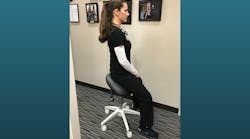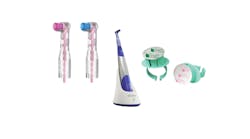I was near the end of hygiene school when I sat on my first saddle stool. It took me all of 10 seconds to know there was no way I could comfortably practice using that stool. The next time I sat on one was eight years into practice, and the dentist had one in each operatory. I groaned when I saw them, but I gave it the old college try, only to have my previous notion confirmed. Parts of me went numb within an hour of sitting on the stool.
Fast forward three years, I became a certified ergonomics assessment specialist, determined to help hygienists avoid workplace-related pain. I kept coming across research to support the use of saddle stools. I couldn’t help but think … was it me? Was I just not built for this otherwise profoundly effective piece of ergonomic equipment?
I eventually found myself in a manufacturing plant with 30-plus different brands and models of saddle-type operator stools. I sat on every single one of those 30-plus chairs and only two fit me! That’s when I knew, without a doubt, that saddle stools are not a one-size-fits-all piece of equipment.
I was then instructed on how to properly sit on and adjust the saddle so that it worked for my body rather than the other way around. This is the foundation of ergonomics—make the environment fit the worker. The right saddle stool for the user makes all the difference in dental practice. Therefore, never buy a saddle stool you haven’t sat on.
One of the most impactful pieces of ergonomic equipment a dental clinician can buy is a saddle stool. But the last thing we want to do is make a quick “click here” purchase for a next-day front porch delivery. Here’s why.
What to look for in a saddle stool
The seat pan width is based on the user’s frame. The height of the cylinder is based on the user’s leg and torso length. It makes sense that if we need different pant sizes, we also need different seat pan and cylinder sizes. It’s the equivalent of having only small or large pants when some of us are short legged with long torsos and others are tall legged with short torsos.
Related reading
Saddle seating: Choosing the right design for the right reasons
You've got a saddle seat. But how does it work?
The height and width of the horn (the part that goes between the legs in front) is determined by the thighs, pelvis bones, and pelvis angulation. Our mandible and maxilla anatomy, as well as pelvis anatomy, differ. The wrong horn size and shape can lead to a posteriorly tilted pelvis or parts becoming numb.
Of great importance is the ability to tilt the seat pan based on the user’s lumbopelvic hip structure. Without this feature, a user cannot make the small adjustments that put them into neutral posture.1 How do you know if you’ve achieved neutral posture? Lift your feet off the ground and see if the body lunges forward or backward. If so, you need to make an adjustment.
It’s essential to know how to adjust the saddle to obtain and maintain neutral posture and reduce pain. These instructions don’t come with next-day delivery or products purchased online. This requires an in-person visual assessment, queuing, and troubleshooting by someone with education and experience in neutral posture. Each person is different.
If the user maintains a pelvic tilt that’s too far anterior or posterior, or if their legs are too far apart, improper size or use of a saddle stool can cause more trouble than was there to begin with. The thing that makes a saddle stool effective is the ability for the user to maintain the natural lumbar curvature with the legs at nearly a 135°. Sitting in a traditional stool flattens that curvature, and when a saddle stool is improperly used, the same thing can occur to one extreme or another.
Less discomfort during clinical work is achievable with the help of a fully adjustable and properly fitted saddle stool. It needs to be comfortable for potentially eight hours a day! You must try the saddle before buying it because you’ll sit in it longer than you sit in your car, on your couch, or on your patio furniture. We don’t buy any of those without trying them first. I have a saddle stool that fits me, and I literally refuse to sit without it. I’d rather stand all day than sit on a traditional stool. I know how to use it and adjust it, and I have zero pain. I definitely want this outcome for all of you perio warriors!
Editor's note: This article appeared in the December 2022 print edition of RDH magazine. Dental hygienists in North America are eligible for a complimentary print subscription. Sign up here.
Reference
- Partido B, Henderson R. Impact of ergonomic training on posture utilizing photography and self-assessments among dental hygiene students and practitioners. American Dental Hygienists’ Association. June 2021, 95;(3):3-31.






